
- Athletics Tutorial
- Athletics - Home
- Athletics - Overview
- Athletics - History
- Athletics - Playing Environment
- Athletics - Equipment
- Athletics - Terminology
- Athletics - How to Play
- Athletics - Scoring
- Athletics - Rules
- Athletics - How to Learn?
- Athletics - Tournaments
- Athletics - Champions
- Athletics - Suprising Facts
- Athletics - FAQs
- Athletics Useful Resources
- Athletics - Quick Guide
- Athletics - Useful Resources
- Athletics - Discussion
Athletics - Quick Guide
Athletics - Overview
Athletics is a collection of sports that include competitions like running, throwing, jumping, and walking. The most common types of athletic competitions include track and field, road running, cross country running, and race walking.
The objective depends on what the sport exactly is. In races, the objective is to run from the starting point to the destination before the opponents do. We will get to know about the objectives in detail later in this tutorial.
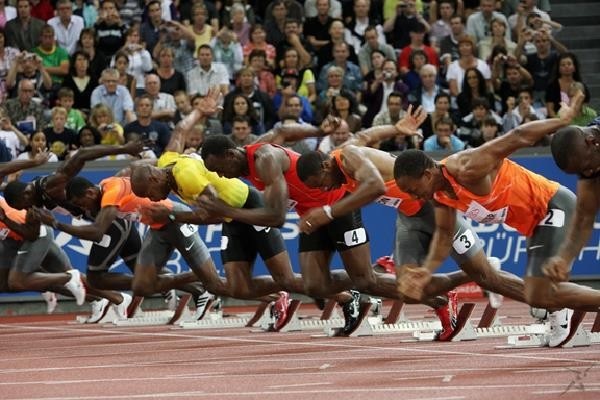
History of Athletics
In the 17th century, a sport festival called the Cotswold Olympic Games came up in England which featured athletics in the form of sledgehammer throwing competitions.
Similar competitions like the L’Olympiade de la Republique were held in the revolutionary France. It is an early variant of the modern Summer Olympic Games. The major event of that competition was a running event with various ancient Greek disciplines.
In 1880, the Amateur Athletic Association or AAA was established in England as the first national body for athletics and it began organizing its own athletics competition every year called the AAA Championships.
The New York Athletic Club of the United States also started organizing national competitions called the USA Outdoor Track and Field Championships in 1876. These sports became codified and standardized by the English AAA and some other general sports organizations in the late 19th century like the Amateur Athletic Union.
In the Olympic Games in 1896, an athletic competition was included as one of the competitions at the quadrennial multi-sport event. At first, it was organized for men only. In 1928 Olympics, women’s events were introduced in the athletics program.
The International Amateur Athletics Federation or IAAF is an international governing body founded in 1912 which changed its name as the International Association of Athletics Federations in 2001. The IAAF established a separate outdoor World Championship in 1983.
The first competitions organized internationally for athletes with physical disabilities (except for deaf), began in 1952 when the first international Stoke Mandeville Games were organized for the World War II veterans. These exclusively included athletes on wheelchairs which introduced the first Paralympic Games which were held in 1960.
To know more about history of Athletics, click the link below −
/athletics/athletics_history.htm/Athletics − History
Athletics − Categories
Athletics can be divided into five different categories −
- Masters Athletics
- Senior Athletics
- Under 23
- Junior
- Youth
In the Masters of Athletics group, age groups spanning five years for athletes aged 35 and above are put. In senior athletics, there is no upper age limit but younger people competing in endurance events have some limitations. Under 23, as it suggests, athletes under the age of 23 are put. Age groups under 20 are kept in the junior group and under 18 are in the youth group.
Athletics - History
Athletics is a sport that consists of different types of events and participants take part in them to win medals. The events include jumping, running, walking, throwing, and a lot more. These contests are also known as track and field events or track in the USA while in other countries it is known as athletics.
History of Athletics
There are no records of the early history of Athletics but it is assumed that It was started by Egyptians and Asian civilizations. It is also believed that Greece was the first country to start athletics between the 9th and 10th centuries BC. Athletics was included in 776 BC in the Olympics which was held in Olympia, Greece. At this time, only a single event was part of the game and it was the stadium foot race which was won by Koroibos.
Athletics was developed in Greece and later it was also developed in Italy in 200 BC.
Athletics was a part of the Olympics till 394 AD and then it was banned because of pagan celebrations. The Roman Empire later on spread the sports in Europe and it again became a part of the modern Olympics.
Inventor of Athletics
There is no information about the inventor of athletics but the first person who won a medal in this game was Korobios. He belonged to Elis, a place in Greece and was a cook.
He participated in a stadium race and won it in 776 BC. He has to cover a distance of 600 feet. Historians believe that there was only a single event in athletics for 13 years. In the Ancient Olympic Games held in Ancient Greece. In the last few centuries, athletics again became popular because of the contribution of many sports persons.
Banning of athletics
Athletics was very popular between 776 BC and 394 AD. Theodosius I was a Roman king who banned the sport because of some pagan celebrations. This led to the death of the game for the next 1,500 years. England again infused life into the track and field game in the 19th century. The first athletics championship was held in England in 1866 after it recovered from its death. This also led to the creation of the Amateur Athletic Club which made rules for different events and these rules are still followed. This club was later renamed as Amateur Athletic Association in 1880. It is the organizer of the annual national championships.
First Modern Olympics
The first Modern Olympics was held in 1896 in which athletics was one of the major sports.
The Amateur Athletic Association still makes rules and follows them and it also approves records.
Historical facts at a glance
- Korobios won the first medal in the Olympics held in Olympia in 376 BC.
- Greece held the Olympic games in Olympia from 376 BC to 394 AD.
- Roman Emperor Theodosius I banned athletics which led to its death for 1,500 years.
- The first track and field games were again arranged in 1154 in London.
- Athletics was again banned by King Edwards III in the 1300s in the British Empire.
- Throwing contests were arranged in the 1600s in the Cotswold Olympic Games.
- Athletics came back in the 1800s as competitions were held by the United States and England. Both countries also formed governing associations for the game.
- Ireland held Lugnasad Festival’s Tailtean games in Ireland and many track and field events were included in this festival
- The first competition for amateur people was arranged in England by the West London Rowing Club.
- The first modern Olympics was held in 1896 and athletics was a part of it which made it a popular sport.
- The International Amateur Athletic Federation was formed in 1912.
- 1960 was the year when athletics was included in the Paralympic games
- Now Athletics is one of the most important sports in the Olympics
Athletics - Playing Environment
The professional athletic competitions almost always take place in either of these venues −
- Stadiums
- Grass courses
- Woodland
- Road-based courses
These venues ensure that all the athletic events that take place in a standardized manner, improving the safety of athletes, and the enjoyment for the spectators.
Track and Field Stadium
A standard outdoor track for athletic races is in the shape of a stadium which is 400 meters in length, and has at least eight lanes. Each lane is about 1.22 meters wide. Earlier, the tracks were covered by a dirt surface. The modern all-weather running tracks are covered by water-resistant synthetic running surface.
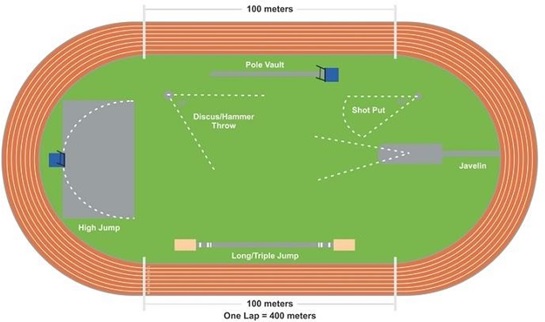
The indoor tracks are designed quite similarly to that of outdoor tracks, but these tracks are only 200 meters in length and have about four to eight lanes with each 0.90 meters to 1.10 meters in width. The bends of these indoor tracks are banked to make up for the smaller turning radius.
There is a 160-yard indoor track at Madison Square Garden used for the Millrose Games of athletics.
Cross-Country Courses
The cross-country competitions are held at venues which have long distance courses for running. As these are performed in open air and over long distances, the courses are heavily dependent and affected by the environment. The natural obstacles, tight turns, and irregular surface make it challenging enough.
In the professional and elite levels of cross-country races, the courses have to be looped. Each lap has to be at least 1750 meters to about 2000 meters in length. All natural and/or manmade obstacles like deep ditches, thick undergrowth etc. must be completed on foot throughout the course.
Road Courses
According to the IAAF, all the courses must be along man-made roads, bicycle paths, or footpaths. The traffic has to be cordoned off the roads during the competition. These races might start and/or finish at a track and field stadium.
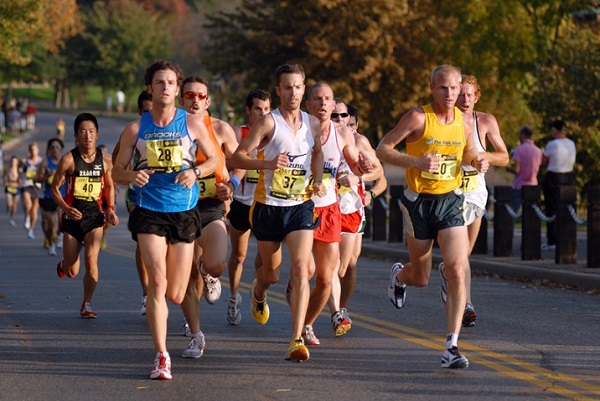
These races can either be looped or from point to point, depending on the area and the organization. The athletes have to cover the distance of 5 km to 10 km. There are medical professionals alongside at certain points for taking care about the health of participants of long distance running.
Athletics - Equipment
Athletics include different types of events like jumping, running, throwing, etc. Each event requires different types of equipment which athletes have to use to take part in the competition. We will discuss about different pieces of equipment used in these events.
Starting Blocks
Sprint athletes used starting blocks in the track and field events. The equipment is used by athletes to hold their feet at the time of starting the race. The blocks are used to prevent slipping when they start the race after the pistol is shot. Starting blocks are used in all high levels of competitions. These blocks have become mandatory to be used in all the sprint races.
Spikes Shoes
Spikes Shoes are also known as track and field spikes. Plastic, ceramic, or metal are used to make these shoes. These spikes are attached to the shoes with the help of screws.
These spikes prevent slipping during the race.
Baton
Baton is a piece of equipment that is used in relay races. It is a hollow tube made up of wood, metal, or any other material. The baton can be 280 to 300mm long with 40mm of outside diameter. It is colored to increase visibility and its weight is 50g.
Hurdles
Metal or similar materials are used to make hurdles. The top bar of the hurdle is made up of wood or other materials. Two feet and two uprights are there which help in fixing the bar at the two ends of the hurdle.
Discus
Discus can be in the form of a disc or a plate and for men, its weight is 2kg and 22cm in diameter. For women, the weight of the disc is 1kg and the diameter is 18cm.
Shot
Shot is a piece of equipment that is used in shotput. Shot is a spherical and heavy object whose weight is 16 pounds or 7.26kg for men. In the case of women, the weight of the shot is 8.8 pounds or 4 kg.
Javelin
Javelin is a spear made up of metal or any other material. It has a pointed tip which is made up of metal. It is used in javelin throw events. Men use javelin whose weight is 800g and length is 2.6 to 2.7m. In the case of women, the length of the javelin is 2.2 to 2.3m and the weight is 600g.
Hammer Iron
Hammer Iron is a piece of equipment in which there is a heavy ball that is attached to a long wire. The length of the wire is 122cm. The weight of the ball for men is 7.26 kg and for women, it is 4kg.
Steeplechase Water Jump
The steeplechase water jump includes a hurdle whose width is 12 feet and height is 3 feet.
The hurdle is followed by a water pit. The depth of the pit is 27.5 feet. The distance of the water jump between the hurdle and end of the water pit is 12 feet.
Weight Cart
Weight Cart is a piece of equipment which is used by the training centers to teach the ways of throwing weights.
Spot Markers
When athletes have to throw a shot put or javelin, there is no way to mark the distance.
The marking was done with the help of a sock or a shoe. Now markers are used and they are available in different colors. These markers are made up of plastic and can be used to mark the distances easily.
Spike Roller
Spike Roller is a piece of equipment that is used to make the grass of the field healthier.
When athletes run on the track, the soil becomes compact. The roller is used to eliminate this compaction.
Mats
Mats are of two types. One of them is the gymnastics mat and the other one is jumping landing areas. The depth of the gymnastics mat is less and it is tougher and springier in comparison to the other mat. The landing area mats are made in such a way that athletes can fall easily without getting hurt.
Sand
Sand is used for the participants of the long jump for landing. Sand is also a great option for marking the distance of each athlete.
No Jump Indicator Board
No Jump Indicator Board is used in the long jump. These boards can be made up of wood or other materials which provide jump lengths of different types. Besides long jump, these boards can also be used in the triple jump.
Long Jump Pit Cover
Long Jump Pit Cover is a cover that is used to cover the pit so that it does not become dirty due to animal dropping. The pit cover also helps the sand to be protected from extreme weather. The pit covers are available in the form of vinyl sheets.
Measuring Tape
Measuring tape is used to measure the distance covered by athletes in the long jump.
Fiberglass is used to make these tapes which make their life longer.
Stand
Stand is used to hold the bar to different heights in the high jump. Stand should be hard and the bar can be easily set on the pegs. A mat-free stand is better to be used for high jump.
Flexibar
Flexibar is used in the jumping events for the safety of the participants. This piece of equipment comes with elastic quality so the chances of getting injured are reduced.
Spreaders
Spreaders are also known by the name of Broadcast Spreaders. This piece of equipment is used for the fertilization of the fields. Large spreaders are expensive but can hold more amount of fertilizer.
Athletics - Terminology
Athletics is a popular sport in the Olympics and many events related to jumping, running, walking, and throwing are held. There are many terminologies used in this sport and we will make you familiar with all of them.
American Grip
This is a way of holding a Javelin. The participant has to hold the cord between his thumb and index finger.
Anchor
The final leg of the competitor in the relay race is termed as anchor. Most skilled runners are given the chance to become anchors. The anchor is responsible for making up the lost time or managing the lead.
Approach Run
The first run in an event of athletics like the Javelin throw, long jump, high jump, etc. is known as the Approach run. The competitor has to take this first step so that he can gain momentum and do the task.
Arena
Arena is a field where all the events of athletics held. The things found in this field are the running track, the spectator's stands, and the grass fields.
Barrel Start
This is a type of race start when the number of runners is more than 20. The traditional waterfall line is the place from where the highest-ranked competitors have to start the race. The runners whose rank is lower have to start from the barrel. Another name for the barrel start is also known as dual alley start. Barrel is a curved start line which is used by lower-ranked competitors to start the race. It is a curved line which can be found at the stagger mark.
Baton
Baton is a hollow tube used in the relay race. This baton is passed from one runner to another in a team. The baton has to be carried till the end of the race.
Bell Lap
The final lap of a race is termed as bell lap. This lap is named as bell lap because when the last lap starts a bell is rung.
Bend Runner
Bend Runner is an athlete who takes part in a relay race and runs with the first or third leg.
Blind Pass
In a blind pass, an athlete passes the baton to the other athlete without keeping an eye on the baton. This type of pass is used in relay races.
Bounding
Bounding is also known as power sprint. There are four styles of long jump and bounding is one of them. In this style of long jump, the athlete has to swing up one arm vertically while the other arm is left behind. This technique provides a large upward impulse.
Break Line
Break lines are the markings on the track which is used as an indicator for the competitors of middle-distance or long-distance races to start running. These lanes are different from the pre-assigned lanes.
Broad Jump
Broad jump is a jumping event in which a competitor has to run and then land into a pit.
The main aim of this event is to travel the farthest possible distance. This event is also known as the long jump.
Cage
Cage is used in the games of discus and hammer throw. The cage consists of a box and is covered with a net so that the instruments thrown do not go outside the competition area.
Changeover
The passing of a baton from one teammate to another is called changeover.
Check Mark
Check mark is placed by an athlete before attempting the approach run.
Chief Photo Finish Judge
He is the one who has to determine the winner of the foot race.
Clerk
Clerk is an officer who is responsible for the enforcement of the rules related to shoes, uniforms, and numbers. He is also responsible for starting an event at its scheduled time.
Climbing
Climbing is a technique of long jump in which an athlete runs while cycling both of his arms and legs which looks like approach run.
College High
In the 110m hurdles race at the college and Olympics events, college high is a hurdle whose height is 42 inches.
Cord
The grip of the Javelin is known as cord. It is a non-slippery part of the javelin which an athlete holds to throw it.
Countback
Countback is a system of declaring the winners in the pole vault or high jump. This system is used when the heights of athletes are the same in both these games. In this system, the number of failed jumps is counted in the whole game or the result can also be declared according to a given height.
Crossbar
The horizontal bar is the bar which is set at a minimum height and a pole vaulter or a high jumper has to cross it to go to the next level.
Crossover
Crossover is a step which an athlete has to use before throwing the javelin. In this step, the leg opposite to the arm holding the javelin has to be brought forward and the arm has to be brought back to throw the javelin.
Crouch Start
This is a common starting position which is used in the hurdle race and 800m events.
Athletes have to touch the ground with their hand, the foot, and the knee of the rear leg.
The head has to be leveled with the back.
Dash
Dash is a foot racing event where athletes have to cover a distance of 100, 200, or 400 meters. Athletes have to take up the momentum and maintain it till the end of the race to win.
Decathlete
Decathlete is an athlete who participates in decathlon.
Decathlon
Decathlon is an event that consists of 10 track and field games and the athlete who scores the highest points is declared as winner.
Discus
Discus is a disc in the form of a lens shape and is made up of different materials like wood, plastic, carbon fiber, fiberglass, or metal. The weight of the discus for males is 2kg and has a diameter of 22cm. The discus used for the women is of 1 kg and has a diameter of 18cm.
Double Arm Takeoff
This is a technique used in high jump. In this technique, the athlete has to see his arms which will help him in crossing the horizontal bar.
Double Arm
Double arm is a technique used in the long jump. In this technique, an athlete has to swing up both his arms which results in a high hip height and large vertical propulsion.
Drive Phase
The beginning part of a sprint or an approach run is called the drive phase where the athlete has to catch high speed.
Drive Swing
Drive swing is a step which a vaulter has to perform while throwing the pole. The vaulter has to bend the pole back and bring their torso backward.
Even Split
This is a strategy which is used by athletes when they have to participate in a middle or long-distance race. Athletes have to run at a steady speed in this event.
Exchange Zone
The length of the exchange zone is 20m. This is a zone where a teammate has to exchange the baton with the other.
False Start
False start happens when an athlete starts the race before the fire. Such an athlete is given two chances but if he repeats it for the third time, he is disqualified and the race is started for the remaining athletes.
Finish Line
Finish line is the white line which indicates that all the foot races will end here. If an athlete crosses this line first, he is declared as the winner.
Flight
It refers to the takeoff during the long jump, high jump, and pole vault where the athlete has to be airborne.
Foul Jump
When the jump becomes invalid during the long or high jump, it is called foul jump.
Foul Line and Foul Throw
Foul line is the line where an athlete has to end the approach run. If an athlete crosses the line during the jump or throw event, it will result in a foul. Similarly, a violation of rules while throwing a discus or javelin is called a foul throw.
Four Point Start
When a race has to be started, the referee has to say get set go. When the referee says Set, the angle of the knee of the rear leg becomes 120 to 140 degrees and the angle of the knee of the front leg is 90 degrees. The hips are also raised high and the body weight is imposed on hands and front legs.
Fully Automatic Timing System
This is an automatic timing system that is being used in track and field foot racing events.
When the referee fires the gun, this timer is started automatically. The device has the ability to capture the timing of each of the athlete participating in the race.
Hammer
Hammer is a ball which is attached to a chain that is used in the hammer throw event.
Hammer Throw
Hammer Throw is an event in which athletes have to throw the hammer which consists of a ball attached to a string.
Heptathlon
Heptathlon is an event which consists of seven track and field games and the athlete with the highest points wins the event.
Hurdle
Hurdle is an obstacle placed on the track and athletes have to jump over it to reach the end and finish the race.
IAAF
IAAF can be expanded to the International Association of Athletics Federations. This is a body that is responsible for making and enforcing rules related to athletics.
Javelin Throw
Javelin throw is an event in which an athlete has to throw a javelin to the furthest possible distance. In the case of men, the weight of the javelin is 800 g and the minimum height is 260 cm. In the case of women, the weight of the javelin is 600 g and the minimum length is 220 cm.
Landing Area and Landing Pit
A thick mat used in the high jump and pole vault is called landing area. The mat is placed behind the crossbar for the safety of the performer. Landing pit is a sunken area that is filled with sand. The pit may also be covered with a thick mattress. The pit is designed in such a way that the athlete does not feel any problem after landing during the high jump.
Athletes have to land on their back and the knees should be bent slightly.
Lap
It is a full round of the track in which the innermost track covers a distance of 400m.
Photo Finish
Photo Finish is used as a piece of evidence in a foot race as it is a series of pictures which can be used to declare the winner of the foot race easily.
Pin
Pin is a small metal piece whose shape is same as a screw. These pins can be found in the soles of spikes that help in managing the grip on the track surface.
Plant
Plant is performed by vaulters in which they have to run and then raise their arms up to the maximum possible height. After that, they have to plant the pole into the side way and then make a jump.
Runway
Runway is made up of polyurethane surface and is used by the athletes participating in the high jump, long jump, pole vault, and javelin throw.
Shaft
Shaft is the actual body of the javelin as the grip and head are attached here. Shaft can be hollow or solid and made up of wood or metal.
Starter's Gun
This is an empty gun fired to start a foot race.
Takeoff Board
The takeoff board is rectangular in shape and is 8 feet wide and four feet long. This board is placed before the foul line in a long jump event. This is a board which athletes use to take off.
Track Event
Track events include different types of events held on the track. These events include sprints, middle-distance races, relays, long-distance races, and hurdles.
USATF
The full form of USATF is United States of America Track and Field and it is responsible for governing all national championships related to track and field. USATF is also responsible for selecting players for the Olympics and Pan American Games as it is a member of IAAF and the United States Olympic Committee.
Athletics - How to Play
According to the International Association of Athletics Federations, athletics includes the following disciplines −
- Track and Field
- Relay Races
- Field Events
- Road Running
- Race Walking
- Cross Country Running
- Mountain Running
All these forms of athletics are individual sports except relay races in which athletes participate in a team.
Track and Field
The track and field competitions came up in the late 19th century and typically athletes who represented rival schools and colleges, military organizations, and sports clubs participated in it. Athletes participated in one or more events according to their choice and favored sport.
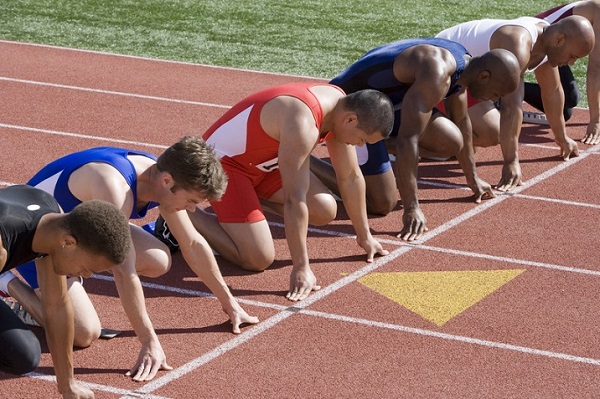
In these events, men and women compete separately. These are played in indoor and outdoor formats. All the indoor competitions are held in winter while the outdoor events are held in summer. Therefore, the name, track and field competitions was defined by the venue of sport.
A variety of running events are held on the track and are categorized according to distance −
- Sprints
- Middle-distance
- Long-distance
Some combined events like decathlons are organized for men and heptathlons for women, where the athletes compete in various track and field events.
The prestigious track and field competitions are held within athletic championships at multi-sport events like the Olympic Athletics Competition and World Championships. The Paralympic Athletics Competition and the IPC World Championships are also organized.
These track and field events have become the most prominent part of the major athletic championships. Many famous athletes come from the world of sports to this discipline.
Relay Races
In relay races, there are four runners in each participating team. When the race starts, the runner has to run to his milestone where he has to pass the baton to his teammate and then he will pass on to the next teammate, with the aim of being the first team to finish.
Running events with hurdles and steeplechase are variations of the flat running themes where the athletes must clear all the obstacles on the track during the race.
Field Events
The field events include jumping and throwing competitions.
Throws
In throwing events, the athletes have to throw an instrument like javelin, discus etc. and the distance to which the instrument is thrown will be measured. Events like shot put, discus throw, javelin throw, and hammer throw are throwing events.
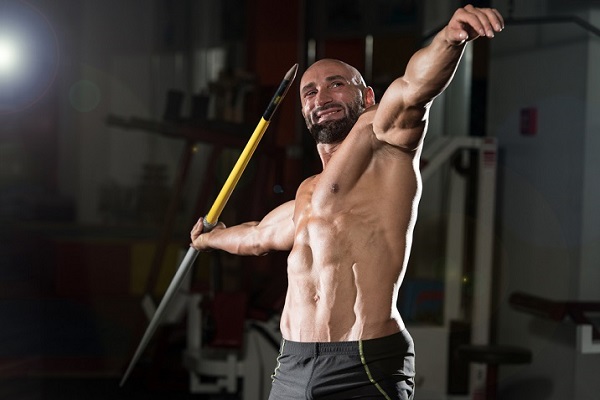
Jumps
There are mainly four types of jumping events −
- Long jump
- Triple jump
- High jump
- Pole vault
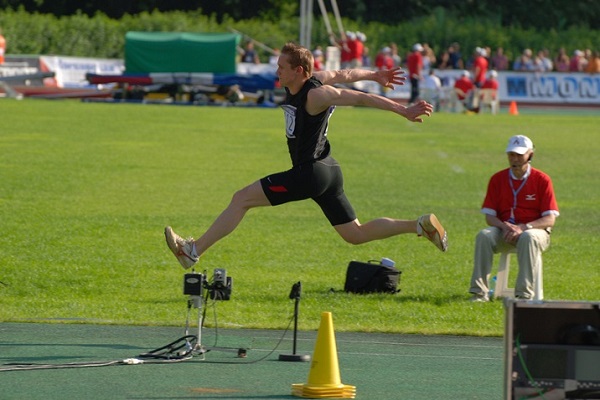
In long jumps and triple jumps, jumps are measured by the distance to which the athlete has jumped. In high jumps and pole vaults, the measurement is done according to height up to which an athlete has jumped.
Road Running
In road running competitions, the athletes have to run long distances on roads which are conducted on course of tarmac roads or paved roads. Most of these races finish in some track of a stadium. The most popular form of this event type are marathon races.
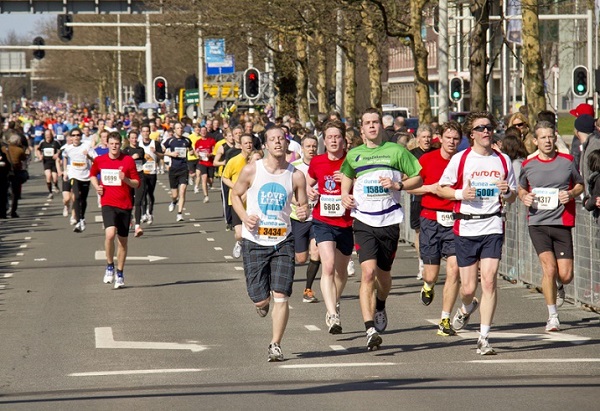
These can be of any distance, but mostly are classified into marathon, half marathon, 10 km, and 5 km races. The marathon races are only one of these events which are held at the IAAF World Championships in Athletics and also in the Summer Olympics.
Half marathon races are held in the IAAF World Half Marathon Championships annually. The marathon races are the only running event held in the IPC Athletics World Championships and in the Summer Paralympics.
The five most prestigious marathon races at the elite level are conducted in the World Marathon Majors series which include the Berlin, Boston, Chicago, London, and the New York City marathons.
This road running sport originated among the male servants who ran alongside the carriages of the aristocrats in the 18th century, and also the people who ran errands for long distances for their masters.
The first modern marathon was held in the 1896 Summer Olympics and this event led to the growth of road running competitions into yearly events like the Boston Marathon, the Lake Biwa Marathon, and Fukuoka Marathons.
Race-Walking
Just like it sounds, race-walking is a form of competitive walking which takes place in the open air − on roads and on running tracks as well. Race-walking is the only sport in athletics which is judged on the basis of the technique used by the athletes.
The athletes must have one foot on the ground with the other advancing leg straightened as to not get an advantage by running a little bit. If the advancing leg is bent at the knee, the athlete is disqualified from the race.
Race-Walking Competitions
The common race-walking events are 10-kilometers, 20-kilometers, and 50-kilometers on roads. In indoor tracks, 3-kilometers race-walking is held for women and 5-kilometers for men.
The topmost level of race-walking competitions is held at the IAAF World Championships in Athletics and also at the Summer Olympics. Race-walking also has its own major competition called the IAAF World Race Walking Cup held since 1961.
In the seasonal competition of the IAAF World Race Walking Challenge, the athletes earn points regarding their performances in the ten selected race-walking competitions. The highest scoring athletes enter into the year’s IAAF Race Walking Challenge Finals.
Cross Country Running
This is the simplest and the most naturalistic sport in athletics. Cross country running events take place in open air courses over surfaces like grass, woodland trails, and normal ground. It can be held either as an individual or as a team sport.
Runners are judged based on their individual performance and points-scoring methods are used in case of teams. These races are held over long distances, as of 4 kilometers or more in the season of autumn and winter.
The first recorded instance of an organized cross country competition was the Crick Run in England, in 1838. Then it gained popularity in British schools and then in American schools in the 19th century. This popularity led to the formation of the International Cross Country Championships in 1903.
Many cross country competitions are held in Asia, Europe, North America, and South America. The cross country competitions were held in the athletics program of the Olympics from 1912-1924, but they are no longer held at the Olympics ever since. However, it is still present as one of the events in the modern pentathlon competition since the Summer Olympics of 1912.
There are various forms of cross country running like mountain running, fell running and orienteering.
Mountain Running
Mountain running also known as Fell Running and Hill Running where racers race with each other off road. The participants must have mountain climbing skills in order to participate in this race. Mountain Running has some common characteristics with cross country and orienteering. In comparison to cross country running, the race courses of mountain racing is long and steep. In comparison to orienteering, the courses are longer but steepness is less.
The participants shall have the capability to navigate the mountains as choosing the route and determining poor weather condition can increase time to reach the destination. In most races, route is published and runners can observe the route which helps them to complete the race in less time. Trail racing is a type of mountain racing in which the course is easy to follow.
Athletics - Scoring
Athletics is a part of Olympics that consists of different events. Each sport has its own scoring system which we will discuss here in detail
100 meters Sprint Scoring System
Automatic scoring clocks are used to calculate the time. The race is finished after the torso of a runner crosses the finish line. A digital scan camera is installed that faces the finish line. This camera is connected to the timing system and provides accurate results.
Cross Country Scoring System
Cross country is a racing game in which teams get a score on the basis of the position of the players. The team consists of five members. The first member gets one point, second one 2 points, third one 3 points, and so on. The team with the lowest score is declared as the winner.
Discus Throw Scoring System
In the discus throw scoring system, the athlete whose discus reaches the furthest distance is declared as the winner. Each athlete gets three chances to throw the discus. The winner is the one who has thrown the discus at the furthest possible distance without stepping out of the circle.
Hammer Throw Scoring System
Each athlete has to throw the hammer six times and each attempt has to be completed within 90 seconds. The athlete whose hammer goes at the furthest distance is declared as the winner. In the case of a tie, second best throw is counted to declare the winner.
High Jump Scoring System
Organizers set a minimum height and athletes have to attempt three times and jump to cross the height. For each attempt, a time of 1.5 minutes is given. If an athlete wants to pass an attempt, he is allowed to do so. If there is a tie between two athletes, then the second attempt is checked. If there is a tie in all the attempts, then athletes have to jump again and only one attempt is given to them. The successful athlete becomes the winner.
Javelin Throw Scoring System
After the javelin is thrown and it lands on the destination, a spike is used to mark the initial impact. The distance is measured in a straight line to the center point of the throwing arc. The result is rounded off to the nearest centimeter.
Long Jump Scoring System
The distance covered by the athlete is measured from the take off line. The destination is the first contact that the athlete has made on the ground. An athlete has to jump three times and the longest distance covered is recorded. The athlete who covered the longest distance is declared as winner.
Pole Vault Scoring System
An athlete has to make three attempts to clear the given height. The vaulter will be given the next height if he clears the current one. The next height has to be crossed with three attempts. If an athlete is unable to cross the given height, he or she is disqualified. The vaulter who has covered the highest height is termed as winner.
Relay Race Scoring System
In the relay race scoring system, the team that completes the race at the fastest speed is termed as winner. Each member of the team has to run on his own distance and then pass the baton. The last member of a team who first reaches the finish line becomes the winner along with the team.
Shot Put Scoring System
Shot Put is a game in which there are two judges who have to look after the results of each round. The scoring in the game is based on the distance from the inside of the throwing circle to the first mark of the landing of the shot put. If the throw is good, a white flag is shown and a red flag is shown for the foul throw.
Triple Jump Scoring System
The score in the triple jump sport is based on the distance at which an athlete has landed after jumping. The distance is measured up to the backmost portion of the body of the athlete that has touched the ground. Athletes are given 3 to 6 attempts and they have to try to reach the farthest distance to win the competition.
Walking Scoring System
Walking or Race Walking is a game in which the player who first reaches the finish line becomes the winner.
Athletics - Rules
Athletics consists of a lot of sports and each of them has different rules which athletes have to follow in order to win the game. We will discuss the rules of different athletics events here.
Hurdles and Sprints Rules
The rules for hurdles and sprints are as follows −
Start
Starting blocks are used to start the hurdles and sprint races. The block consists of two adjustable foot plates which are connected to the right frame. Firing through the starting pistol is used to start these races The announcer has to say "On your marks, set” and then the pistol is fired after all athletes come to the set position.
In the case of 100m, and 110m races for men and women, the athletes are lined up. In the case of 200m, and 400m sprints and hurdles, staggered positions are used to start the race. It is so because the lanes are curved.
False Start
If the pistol is not shot and one or more athletes start the race, it is called false start. The runner who commits this mistake is disqualified if he does so three times.
Lanes
Each player has to stand and run in the lane he or she has been assigned. The width of a lane is 1.22 meters. The lane inside is numbered 1 and the outer one is numbered as 8.
If an athlete runs in a lane not assigned to him, he is disqualified. In case an athlete is forced to leave his lane and run in another lane, he will not be disqualified.
Finish
The athlete who first reaches the finish line wins the race.
Middle Distance Races Rules
Here are the rules for middle-distance races.
Start
For the races whose distance is 800m and above, no starting blocks are used. Runners have to be in their upright positions and their hands should not touch the ground. After the announcer says On your marks, the pistol is fired after all the athletes are at the mark.
There are 8 runners in the 800m race and 12 in 1500m. A group start is used for the 1500m race.
Lanes
Players will have to stay in their own lane during the first run in the 800m. After that, they are allowed to move to the innermost lane. This point is known as break line. No lanes are assigned in the 1500m race. Runners can change their positions from the start.
Long Distance Races Rules
Here are the rules for long-distance races.
Start
No starting blocks are used and runners have to stand upright and their hands should not touch the ground. The announcer announces On your marks. When all athletes are on their mark, the pistol is fired to start the race. More than 12 competitors can compete in this race. These people may be divided into two staggered groups. The first group has to start the race from the regular start line and the second one has to start from a separate one.
Race Walking Rules
Race walking is a race in which athletes have to move constantly till the end of the race.
The athletes should be in an upright position while walking.
Judges
The race is observed by six to nine judges whose duty is to give warning to the participants.
If a participant gets a warning from three different judges, he or she is disqualified. If an official medical staff member suggests an athlete to retire from the race, the competitor should do so. A competitor may also leave the race by taking permission from the judges on the condition that the racing distance is not shortened.
Jumping Events Rules
Let us know the rules of different jumping events
High Jump
Athletes participating in the high jump have to take off through one foot only. If the crossbar falls down while jumping, it is termed as failed event.
Pole Vault
Players participating in pole vault are allowed to put a substance either on their hand or on the pole so that a better grip can be made. Athletes are not allowed to keep a tape on their fingers. They can do so only if any of the fingers is injured. These poles can be made up of different materials and there is no restriction on their length or diameter.
The reasons for the failed attempts are as follows −
- If the bar is touched by an athlete and it does not remain on pegs
- If the lower hand is moved above the upper one
- If the upper hand is higher on the pole
- If the bar is replaced during the vault
Long Jump
Long jump is an event in which the measurement is done from the spot of the takeoff to the place where any part of the body of the athlete lands. Failed attempt occurs in the following cases −
- If an athlete touches the ground that is beyond the take-off line
- If the takeoff is done outside the takeoff board
- If an athlete touches the ground outside of the landing area on the landing
Triple Jump
Triple Jump is an event which consists of three steps known as hop, step, and jump. In the case of hop, athletes have to use the same foot for landing which they have used for making a hop. In the case of step, athletes have to use one foot for step and the other one for landing. Failed attempts in triple jumps occur in the following cases −
- If an athlete touches the ground that is beyond the take-off line
- If the takeoff is done outside the takeoff board
- If an athlete touches the ground outside of the landing area while landing
Throwing Events Rules
Many throwing events are organized in the Olympics, Asian Games, and other tournaments. Here are the rules to be followed by athletes.
Implements
Implements that athletes use should have the same specifications as per the rules made by the IAAF (International Association of Athletics Federation). Athletes are not allowed to modify the implements and they cannot use any device for assistance like tapes on the fingers, Tapes can be used on wounded fingers if required.
Throw
The throwing events organized in a tournament like the Olympics are Shotput, Hammer Throw, and Discus Throw. All three throws of these events have to be done from a throwing circle. The throw is failed if an athlete comes out of the circle or runway while throwing.
The throw is considered valid if the equipment falls within the landing area. Athletes are not allowed to leave the till the time the equipment touches the ground.
Athletics - How to Learn?
Athletics consists of different games and we will look at the ways of learning some of them.
Sprint 100 Meters
Sprint 100 meters is a race in which an athlete has to run as fast as possible to reach the finish line and win the game. There are many methods that athletes can adopt to run as fast as possible. We will discuss some of these methods.
Maintain proper sprint mechanism
If you want to win the 100-meter sprint, you need to maintain proper posture. Along with this, you have to relax your shoulders and neck and your spine should be kept straight.
Hands and fingers should also be kept loose.
Warm up
Before starting the race, you need to have a warm up in which your muscles should be loosened and you also need to have dynamic stretching. Your blood circulation will increase due to the quadriceps, hamstrings, calves, and glutes. This will prevent injury and help you to gain momentum.
Use ball of feet
You have to use the ball of your feet to run to gain momentum and run fast.
Arm action should be controlled
If the right leg is in front, the right arm should be back. Similar should be the case with the left arm and leg. This will help in balancing the torso. The arms should be moved forward and backward.
Short length of steps
You need to take small steps so that the efficiency of your running and momentum can be increased.
Cross-Country
Cross country is a long-distance race and you have to follow the tips below to win it.
Check the map and location
Before participating in the race, you need to know about the starting and finishing location along with the route of the race. There is a map which you have to check to determine the route. You will find hills, junctions, and many other things. It is better to walk on the course a day before the race.
Go for training runs
It is one of the best options to go for a training run. You may find mud or sand sections along with narrow trails, large hills, and other things. A training run will let you know about the course.
Outfit should be ready beforehand
You need to make sure that the outfit you will use for the race is ready before the date.
You may have to wear tight clothes and the best shoes that will fit your terrain. If the course is muddy, you need to go for the shoes with pins. Also, make sure that the outfit is fit and it is comfortable for you during the run.
Discus Throw
Here are the steps that you can follow to throw the discus successfully.
Grip
The hand which you have to use to throw should be below the discus. The thumb should be put on top and the fingers should be properly spread.
Stance
Your face should be away from the target and feet should be spread and their distance should be greater than the shoulder width.
Starting the throw
The shoulders should be rotated in the direction of the throw. Raise the right foot while keeping the weight on the left one. Now spin your left foot towards the center of the ring.
Release
Now keep the throwing arm back while spinning on the left foot and then release the discus towards the target. The angle of the throwing arm should be approximately 35 degrees.
Hammer Throw
Hammer throw is a game in which a heavy ball is tied to a string and is thrown towards the target. The steps mentioned here are for the right-handers. The left-handers have to do the opposite.
Pick and hold the hammer
Keep the right hand on the top of the hammer and the left hand at the bottom.
Winding the hammer
The right hand should be straight and relaxed when the ball is in the front and bend when the ball is at the back. Minimize the motion of the hips and shoulders by having a strong torso.
Release the hammer
The ball should be pushed when it comes on the right-hand side. The weight of the body should be on the left heel while throwing.
High Jump
There are a few steps which beginners have to master to become an expert high jump athlete. These steps are discussed here in detail.
Approach
The first step is an approach which you have to master. Easy attempts may also be missed if the approach is not correct. You have to practice the 10-step approach in which five steps should be taken on the straight line and the remaining five on the curve. The foot that you will use to take off should lead the approach. Start accelerating and make your strides fast on the curve.
Takeoff
You need to be at a very good speed for the takeoff. You need to keep in mind that you will go high if you run at a good speed in the approach step. Try to take off in a vertical position. While taking off, the back of the body should face the bar. After planting the leading foot, drive it upwards and jump high while being parallel to the bar. Your arms should be parallel to the bar.
Flight
Bend your knees when you are in the air after jumping. The distance between your knees should be large. The knees should be towards the head to cross the bar successfully. First, the head crosses the bar, and then the hips. Bring your legs upwards so that they also cross the bar. Now use your shoulders to land on the mat. Your chin should be touching the chest.
Javelin Throw
Javelin throw involves three steps which you have to learn to become a perfect javelin thrower.
Grip
There are three types of grips which can be used to hold the javelin.
- American-style grip in which the cord is held between the thumb and the index finger
- Finnish-style grip in which the thumb and middle fingers are used to hold the javelin’s cord
- Fork-style grip in which the index and the middle fingers are used to hold the cord of the javelin
Run Up
You have to run at a fast speed on the runway and carry the javelin in your hands. While running, the javelin should be held high. Now the body should be put in a proper position to make the throw easy.
Throwing
Some coaches may give a ball instead of a javelin to you to learn javelin throw. If you get a javelin, you may have to perform drills or throw the javelin while standing. After that, you can run a few steps and throw the javelin.
Long Jump
In order to learn the long jump, you need to go through the four phases discussed below in detail.
Run-Up
This is a phase in which you will have to run with consistency and speed. This will boost you up before takeoff. You will be able to cover more distance if your speed is great and consistent. Another thing that you have to consider is the foul line and you have to take off before this line.
Takeoff
The leg that you want to use for takeoff should touch the ground. The takeoff leg for right-handers is left and for left-handers it is right. The leg to be used for takeoff should be put flat on the ground. Your speed will be reduced when you take off.
Flight
The flight techniques used by athletes are −
- The sail
- The hang
- Hitch-kick
The last two are commonly used only in the case when an athlete has the ability to jump 5m more. The sail is a flight technique developed for beginners.
Landing
In the case of landing, you have to bring your head towards the knees and take the heels upwards.
Pole Vault
Pole Vault can be learned by following the steps discussed below.
Grip
The first thing that you have to learn is gripping the pole. You will have to think about the proper positions to hold the pole. Even your trainer will also let you know about these positions.
Approach Run
You have to hold the pole and run at a fast speed. You need to go for approach drills which will help you in improving your approach run. The movement of hands and arms should be reduced to a minimum so that planting the pole becomes easy.
Planting and Takeoff
The aim of the pole vault is to convert the horizontal movement into vertical jump. If you are a beginner, you need to go for drills so that you can learn about planting the vault.
The tip of the pole should be planted and the vaulter should jump vertically and land on the sand or mat.
Shot Put
Here are the steps that you need to follow to become an expert in shot put.
Grip
This is the first step in which the shot has to be placed on the base of the fingers. While holding the shot, you need to spread your fingers a little. Keep your thumb below the throwing elbow and the angle of the throwing arm should be at least 45 degrees.
Stance
If you are a right-hander, place your right foot near the circle edge while the left foot should be put forward. The right foot has to bear most of your body weight. Go into the seating position by bending your knees. Line up the toes of your left leg with the heel of your right leg.
Glide
Glide in front of the circle while pushing the right foot and keeping the left leg forward.
The left foot should be used for landing after gliding and your right foot should be placed in the middle of the circle. The knees should be bent at 75 degrees and your right leg should bear most of the weight.
Throw
Keep your left arm firm and upwards and throw the shot with your right hand.
Athletics - Tournaments
International Association of Athletics Federation
The international governing body for athletics is the International Association of Athletics Federation (IAAF) which was founded in 1912. The organization was initially known as the International Amateur Athletics Federation but changed in the late 1970s as to remove the word amateur from the name and focus on professionalism.
The IAAF currently has 213 member nations and territories which are divided into six continents – Asia, Africa, Europe, Oceania, North America, and South America.
All the sports which come under athletics do not have their own independent governing bodies at international or continental level, rather all fall under the athletics authorities −
AAA − Asian Athletics Association
CAA − Confederation of African Athletics
CONSUDATLE − South American Athletics Confederation
NACACAA − North America, Central America and Caribbean Athletic Association
EAA − European Athletics Association
OAA − Oceania Athletics Association
All these organizations are responsible for regulation of athletics within their respective countries. The major competitions have a form of permit from their respective national body.
Competitions
The athletic competitions are divided into three types −
International Championships − In international championships, athletes who represent their country or region compete with each other.
National Championships − National championships are endorsed by a national governing body which decides the best athletes of the events for the country.
Annual meetings and races − Annual one-day meetings and races are the basic level of competition. They are often invitational and organized by sports organizations, sports promoters, and other institutions.
Olympic Games
The first event of athletics in a global arena was held at the Summer Olympics in 1896. The four major sports of athletics have been featured in the Olympic athletics program since its very beginning in 1896. However, the cross country races have been dropped out the program.
The competitions of the Olympic are the most prestigious athletics contest as they are the most watched events of the Summer Olympics. There are a total of 47 athletics events held at the Olympics, in which 24 are for men and 23 are for women.
Paralympics Games
The Summer Paralympics are organized for athletes with a physical disability. Competitions of track and field, and road events have featured the Paralympic athletics program since its origin in 1960. This competition is the most prestigious athletics contest for the physically challenged.
Athletics events like wheelchair racing are held in which the athletes compete in lightweight racing chairs. A sighted guide is provided to the visually impaired contestants. In 2012 Summer Paralympics in London, medals were given to the guides for piloting in cycling for the first time.
International events for athletes with physical disabilities are held since 1952. The International Paralympic Committee is responsible for the competitions in athletics, and hosts the Paralympic Games for the physically challenged since 1960.
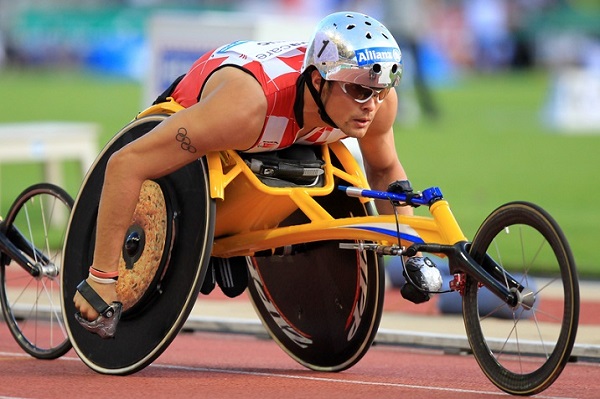
In the elite level competitions, the competitors are classified by their disability so as to keep the athlete with similar disability in the same event. For example, a T12 classified athlete is visually impaired, so all visually impaired participants will be kept in T12.
The following is the order of classification for physically challenged −
- F − Field athletes
- T − Track athletes
- 11 to 13 − Visually impaired, they compete with a sighted guide
- 20 − intellectual disability
- 31 to 38 − Cerebral palsy
- 41 to 46 − Amputation and athletes with dwarfism
- 51 to 58 − Wheelchair
In wheelchair racing, the athletes compete on lightweight racing chairs. Most of the major marathons have separate divisions for people on wheelchairs and the elites consistently beat the runners who were on foot.
The speed of the wheelchair can, and has caused issues for the race organizers as they cannot properly stagger their start times as compared to runners. There was a case of collision of wheelchairs between Josh Cassidy and Tiki Gelana at the 2013 London Marathon.
World Championships
The primary global athletics championships are held by the IAAF called the IAAF World Championships in Athletics. This features an event program quite identical to the Olympics. Athletics like road running, race-walking, and track and field are featured in the competition.
Although cross country running is not held at the World Championships, it has its own discrete global championships called the IAAF World Cross Country Championships. These cross country championships have been held annually since 1973.
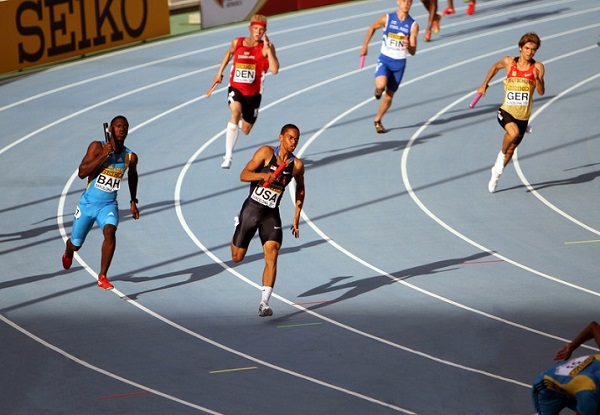
IAAF Championships
Exclusively for track and field events, there are championships by the IAAF called as the IAAF World Indoor Championships in Athletics. There are IAAF World Half Marathon Championships annually as the foremost separate road running event.
For race-walking, there is no world championship status but the IAAF World Race Walking Cups fills in the job for race-walking. The outdoor track and field is the only sport which is not competed globally as a championship but has its own genre made by the IAAF called as the IAAF Continental Cup.
The IAAF Continental Cup is made for the sole purpose of outdoor track and field events. There are other world championships like the IAAF World Junior and World Youth Championships in Athletics, for the athletes who are under the age of 19 and 17, respectively.
Commonwealth Games
At the Commonwealth Games, athletics is one of the sports which gets quite a lot of attention along with other major events. It has been in the Commonwealth Games since its inaugural edition, the 1930 British Empire Games.
Athletics - Champions
There are many events held in athletics like races, jumps, throws, and many more. Some of them to mention are races, marathon, long jump, high jump, triple jump, javelin throw, shotput, discus throw and many more. Some athletes take part in one event only while others take part in multiple events. Here is the description of some of them.
Usain Bolt
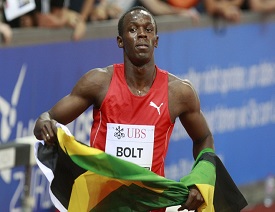
Usain Bolt is a runner from Jamaica who has made records in 100m and 200m races. Along with these, he has also set record in 4 × 100m relay race. He has won six gold medals in Olympics. He has won 100m and 200m races consecutively in 2008 and 2012 Olympics.
In addition, he has won 200m race in 2013 World Championship. Bolt started his career in 2004 from Carifta games at a junior level. Previously also, he has won many races at junior level.
Dai Greene
Dai Greene is an athlete who plays for Wales and Great Britain. He is a specialist in 400m hurdle race. At junior level, he won a silver medal in 2005 European Junior Athletics Championship and gold medal in 2007 European Athletics U23 Championships.
He started his career at senior level in 2009 where he set a record in 400m in Josef Odložil Memorial. In 2009 World Championship, he won a silver medal in 400m hurdles. He won a gold medal in 2010 in European Athletic Championships and another gold in 2011 in World Athletic Championships.
Ezekiel Kemboi
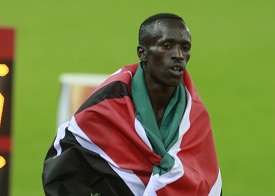
Ezekiel Kemboi is an athlete from Kenya who is the winner of 3000m steeplechase at 2004 Olympics. He also won many championships in the years that followed.
He started his career as a junior athlete in 2001 where he won African Junior Championship and finished second the following year in Commonwealth Games. He won a silver medal in 2005 and 2006 in various championships. Then he won a gold in 2011 World Championships.
Derek Drouin

Derek Drouin is an athlete from Canada who takes part in high jump. He won two bronze medals one in 2012 Summer Olympics and other in 2013 World Championships. Currently, he is a world champion in Pan American Games and Commonwealth Games.
He achieved his first success in 2009 Pan American Junior Championships. He took part in 2012 Summer Olympics and won a bronze medal in high jump. Then he again won a bronze medal in World Championship in 2013. After this, he won a gold medal in 2014 Commonwealth Games.
Greg Rutherford
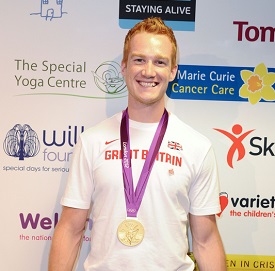
Greg Rutherford is an athlete who represents Great Britain in various competitions. He has won gold medals in various championships like 2012 Olympics, 2014 Commonwealth, European Athletics Championship, and 2015 World Athletics Championships. Rutherford started his career in 2005 where he became the youngest long jump champion by winning AAA Championships.
In the same year, he also won European Junior Championships. Then he took part in 2006 Commonwealth games but could not succeed. In the same year he again won AAA and European Championships. He could not win any medal in the following years due to injuries.
Caterine Ibarguen
Caterine Ibarguen is an athlete from Columbia who takes part in three athletic events namely high jump, long jump, and triple jump. She has won two gold medals in IAAF Championships and silver medal in 2012 Olympics.
Besides this, she participated in Pan American Games held in 2011 where she won two golds. In 2014, she won diamond league as she got a gold in triple jump. After this, she won a silver medal in 2012 Olympics and a gold in IAAF Championships in 2013.
Valerie Adams
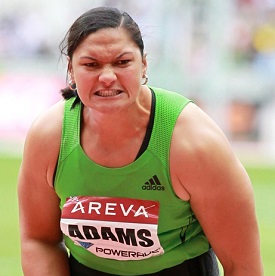
Valerie Adams is an athlete from New Zealand who participates in shotput throw. She won two times in Olympics and three times in Commonwealth Games. Besides this, she also won World Championships four times and World Indoor Championships three times.
Adams started her career in 2001 where she won World Youth Championship. In 2002, she won World Junior Championship and a silver in Commonwealth Games. In 2005, she won a bronze medal in World Athletics Final but was promoted to gold as the results were nullified for Nadzeya Ostapchuk.
In 2007, she won IAAF World Championship where she has to compete with Nadzeya Ostapchuk. After this, her next achievement was a gold in Beijing Olympics.
Denia Caballero
Denia Caballero Ponce is an athlete from Cuba. She mainly participates in discus throw event and has the best throw of 70.65 metres. In 2011, she won Pan American Games. In the starting part of her career, she took part in Javelin Throw and became Cuban Junior Champion.
Caballero won a bronze medal in 2010 in Barrientos Memorial Championship in the discus throw event. In 2011, she won a gold medal in 2011 Central American and Caribbean Championships in Athletics. In the same year, she won a bronze medal in Pan American Games.
Christina Obergföll
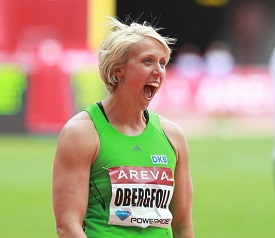
Christina Obergföll is an athlete from Germany who has made many records in Javelin Throw. She won a silver medal in 2005 World Championships. In 2006, she ranked fourth in European Athletics Championships and later she won European Cup Super League in 2007.
She is also a winner of bronze medal in 2008 Olympics whereas in 2012 Olympics, she won a silver medal. In 2013 World Championship, she won a gold medal.
Anita Włodarczyk
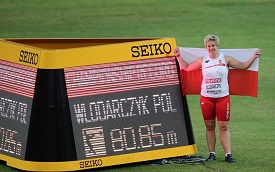
Anita Włodarczyk is an athlete from Poland who participates in hammer throw event in athletics. She holds the record of 81.08 metres throw and is the first woman athlete to make this record. She won National U23 Championship in 2007 and in the same year, she competed in European Championship. In 2008, she won a bronze medal in 2008 World Athletics Final.
She won her first gold medal in 2009 World Championships. In 2010, she won Meeting Grand Prix IAAF de Dakar and a bronze medal in 2010 European Championship. In 2012 Olympics, she won a silver medal in hammer throw.
Athletics - Suprising Facts
Athletics is a sport in which athletes have to participate in different events which include jumping, running, throwing, etc. There are many surprising facts about the sport and we will discuss them here.
Oldest Sport
Athletics is considered as one of the oldest sports as it was a part of the 776 BC Olympics.
Many civilizations from Greece, China, and Egypt participated in different sports like running throwing, and jumping competitions.
Main Event in the Olympics
Athletics is one of the main events in the Olympics.
Record in Sprints
Usain Bolt has made records in 100m and 200m sprints and became the greatest athlete.
Challenging Event
Pole Vault is considered as one of the most challenging events in athletics where athletes have to achieve maximum height.
Naming of Marathon
Marathon is named after one of the Greek towns named Marathon where Pheidippides the Greek messenger ran to declare the victory of Greece over Persians.
Types of Events
Athletics has indoor and outdoor events which include city streets, stadiums, and indoor tracks.
High Jump Techniques
Previously Scissors Jump technique was used in the high jump but now, the Fosbury Flop technique is used. This technique was developed by Dick Fosbury.
Origination of Javelin Throw
Javelin Throw is an event in athletics that has been developed as a hunting technique.
Record for Women's 100m Sprint
The record for 100m sprint for women belongs to Florence Griffith-Joyner
Game that requires a lot of Power and Strength
Shot Put is a game in which a lot of strength and power is required to throw a heavy metal ball.
False Start
Athletes should prevent false starts as this can lead to disqualification.
Long Distance Events
Different types of long-distance events are organized in athletics. These include races of 5,000m and 10,000m.
Triple Jump
Triple Jump is a combination of running, jumping, and bounding.
Hurdling
Hurdling is an event in which athletes have to race with each other and cross different barriers called hurdles.
Decathlon and Heptathlon
Multi-event competitions are also held in athletics and they are known as decathlon and heptathlon. Ten games are included in decathlon for men and seven in heptathlon for women.
Participants and their age
Athletes of any age can participate in athletics competitions.
Eight Records in One Day
Fauja Singh made 8 records in one day in the following events −
- 100m
- 200m
- 400m
- 800m
- 1500m
- 3000m
- 5000m
- The mile
He made this record at the age of 100.
Steeplechase Event
Steeplechase Event has its origins in Ireland. In this game, athletes have to run 3000m while crossing 28 obstacles and 7 water jumps.
Highest Pole Vault
The record for the highest pole vault was made by a Swedish athlete named Armand Duplantis. He went up to a height of 6.18 meters. In the female section, the record was made by Yelena Isinbayeva from Russia. She went up to a height of 5.06 meters.
Hammer Throw World Record
The record of hammer throw for males is 86.74 meters and for females, it is 79.42 meters.
Number of Participating Countries
Athletes from around 200 countries participate in athletics.
Name of Running
Running was known as Pedestrianism in the late 19th century.
Number of Muscles in Running
Each step in running uses 200 muscles.
Chances of Arthritis
Running reduces the chances of arthritis.
Famous Sport
The number of people engaged in jogging, running, and trail running was 60 million in the United States in 2017.
Athletics - FAQs
The track is oval in shape and covers a distance of 400m. There is also a 100m dash for organizing 100m races. There are eight lanes on the track.
Field athletics include two types of events which are jumping and throwing. Here are the sports included in both of them −
Jumping events
- Pole Vault
- Triple Jump
- High Jump
- Long Jump
Throwing Events
- Hammer Throw
- Discus Throw
- Javelin Throw
- Shot Put
The athlete who receives the highest payment is Usain Bolt who currently has a worth of more than $30 million.
The winners of most medals won by different athletes can be found in the table below −
| Athlete | Country | Gold | Silver |
|---|---|---|---|
| Paavo Nurmi | Finland | 9 | 6 |
| Carl Lewis | USA | 9 | 1 |
| Usain Bolt | Jamaica | 8 | 0 |
| Ray Jumper | USA | 8 | 0 |
| Allyson Felix | USA | 6 | 3 |
No! Athletes are not paid for their participation through prize money. Their income comes through sponsorships, endorsement, and other types of outdoor revenue streams.
Yes! Shoes with spikes are required for running. These shoes should be of high quality. If athletes will use shoes of low quality, it will cause discomfort while running.
If an athlete false starts three times, he or she is disqualified.
If an athlete falls in a long-distance event by contacting with other athletes, the gun is fired again. This does not happen if an athlete slips.
Yes! Runners can wear watches while running.
These blocks are similar and athletes use different names. The starting blocks are used by athletes to get support when the race is starting. These blocks prevent slipping when the race is started.
Starting blocks are used in all the races including relay races.
Sprint Races are of short distances which include 100m, 200m, and 400m distance.
The participation of women in the high jump was started in 1928 at the Amsterdam Olympics.
Athletes can use any foot for takeoff. Only one foot should be used.
The high jump field is divided into three parts. The first part is the runway where athletes have to run. The second is the crossbar located on an upright. The third is the mat where athletes fall after the jump is complete.
The event starts after the chief judge puts the bar on the upright. The height of the bar is increased gradually.
An athlete is given three chances to clear a height. The athlete will have the option of skipping only a single height and going for the next one.
Triple Jump was included in the Olympics in 1896.
The steps used in the triple jump are hop, skip, and jump.
Triple jump was added as a women's event in the Olympics in 1996.
Renaud Lavillenie made a record of 6.16m in 2014.
Pole vault was added for men in 1896 and for women in 2000.
An athlete gets three chances to achieve the given height. On failure, the athlete is disqualified.
Discus throw for men was added in 1896 and for women in 1928. Besides the Olympics, the discus throw is also added in the decathlon.
The weight of the discus for men is 2kg and for women 1kg.
The diameter of the circle is 2.5m.
If an athlete crosses the circle before the discus reaches the destination, it is termed as a foul throw.
The USA is the most successful country as it won gold in every competition held between 1896 and 1968.
Brass or iron is used to make the shot.
The length of a Javelin for men is 260cm and weight is 800g. In the case of women, the length of the javelin is 220cm and weight is 600g.
Most of the records regarding javelin throw belong to Sweden and Finland.
The three parts of a javelin are a head, a shaft, and a cord grip. The main body of the javelin is a shaft which is made by using a metal or any other material. The shaft does not have any grooves, holes, or ridges, and also it is not rough. The head of the javelin is its front portion which is pointed. The center of the javelin is fixed with a cord grip.
Hammer Throw made its debut for males in 1900 and for females in 2000.
An athlete has to make three turns before making a throw.
The weight of the hammer for males is 7.26kg and for females, it is 4kg.
The games added to the decathlon are as follows −
- 100m dash
- Long jump
- Shot put
- High jump
- 400m run
- 110m hurdles
- Discus throw
- Pole vault
- Javelin throw
- 1500m run
The first five are arranged on the first day and the remaining five on the second day.
Decathlon debuted in the Olympics in 1912.
Heptathlon was introduced for women in 1984 Summer Olympics.
To Continue Learning Please Login